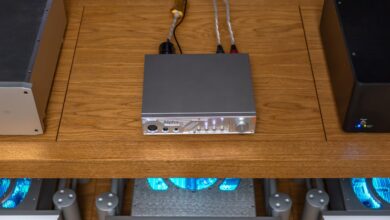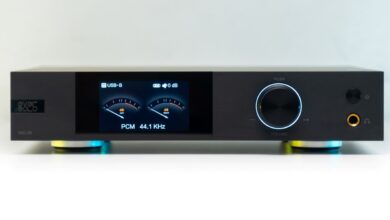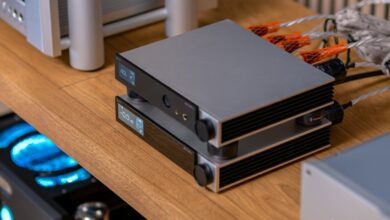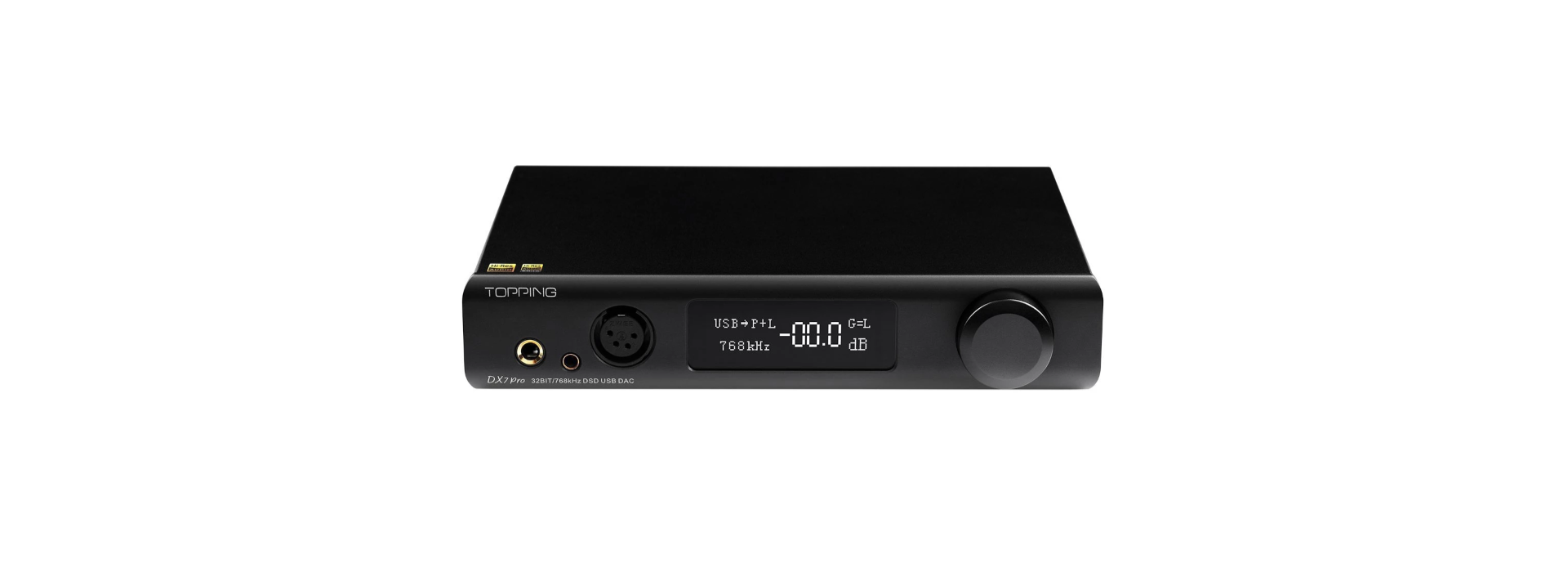
Disclaimer: Topping DX7 Pro was sent to us as a review unit in exchange for our honest opinion. We thank team Apos Audio for this opportunity!
My Unboxing Video:
My Full-Video Review:
In January 2019 Topping announced that they are almost finishing their flagship DX7 PRO DAC and everybody prepared their wallets and some romantic stories for their wives, fast forward in April it was revealed that they are still tuning the DX7 PRO and are assuring a polished device with good specs and impressive measurements will come out of their labs. In September we are assured no other delays will happen and that it entered final production stage. At long last, after a long 9-month wait time of adjustments and tuning DX7 Pro sees the light of the day. I personally don’t mind waiting for a mature and polished product, I’ve seen multiple flawed devices (especially smaller portable ones) at their launch and nobody was happy with those.
We already tested their D70 DAC and were impressed by its build, specs and measurements, but most importantly by its sound performance and incredible value. Want it or not, Topping is growing fast and as far as I can tell their D90 will be the first commercial DAC with the flagship AKM4499 DAC chip inside.
DX7 PRO is an updated version of the acclaimed DX7S that at that time replaced the DX7, as you can see DX7 PRO is the third iteration of the all-in-one DAC/Preamp and headphone amp combo, DX7 PRO has now even some powerful Bluetooth capabilities, should it also be called as a streamer? Not really, since both AptX-HD and LDAC are still not capable of delivering bit-perfect Hi-Res data streams, but in time with new tech that will surely happen.

So, if you are wondering what exactly was improved or changed or maybe left unchanged? Let’s take a closer look.
- It seems that DX7 Pro uses a slightly smaller and thinner case losing a bit weight in the process, it is now at only 1.4 Kg
- DX7 Pro has an additional digital input – I2S input, from my listening tests this is the best digital input, closely followed by USB
- DX7 Pro has also an additional Bluetooth receiver, actually the best Bluetooth receiver as of right now (CSR8675 from Qualcomm), this one is capable of receiving AAC, SBC, aptX, aptX-LL, aptX-HD and LDAC for up to 990 kb/sec wireless transmission. Bluetooth version 5.0 and the included antenna help a lot in maintaining a clear and stable wireless signal even with 3 concrete walls between the sender and the DX7 Pro
- Probably the biggest change is moving from a dual 2-channel ES9038Q2M mobile DAC chips to a single but more advanced 8-channel and desktop class ES9038 PRO
- DX7 PRO moved to 3 high-performance Accusilicon AS318-B femtosecond crystal oscillators, combined with a better DAC chip the total-harmonic-distortion (THD) was lowered by 5 times compared to DX7S! It sits at only 0.000084%, SINAD improved as well and on the XLR out it shows an impressive 121 dB, that is world class performance by my standards.
- Another great improvement is the headphone amp section, DX7s was no slouch with headphones and could drive almost all of them except for current hungry headphones like low sensitivity planar-magnetic headphones. From a full 1 Watt of power on DX7s, newer device upped the game and delivers a whopping 1.7W in the same 32 Ohm impedance. This power increase was targeted mostly at planars that are mostly current and not voltage driven (as opposed to dynamic driver headphones)
- There are other smaller improvements, like higher SNR on the balanced out and on the headphone out (by 3dB) and fewer things that only an Audio Precision APx555 will show you (IMD hump is almost gone).
- Of course, all those improvements come at a price, DX7 PRO costs $599 and DX7s $499, however only those 3 femtosecond crystal clocks are costing more than $100 so I consider the higher price fully justified.

Unbox Therapy
Unboxing experience is very positive, no complains here. Double boxed? Check! Thick card-board box? Check! Lots of foam for extra protection? Triple Check!
Inside the box you’ll find: DX7 Pro unit itself, a power cable, a USB type-B cable, a headphone adapter, a screwing type Bluetooth antenna, a much-needed remote control, a warranty card and a very in-depth to the smallest details user manual. What I really like about this user manual is that Topping actually published actual audio performance measurements recorded by world’s best audio analyzer: Audio Precision APx555. Basically, everything from FFT Spectrum, harmonic distortion ratio, Inter-modulation distortion ratio (IMD) and RMS levels for both the RCA and XLR out, everything is included in there. Want to use the i2S input but don’t know the exact phase settings of the external S/PDIF interface, the manual has all those i2S phase settings too. They did exactly like that with the D70 and with newer devices. I also like that all the usual audiophile marketing snake-oil is not present in the manual, just pure specs and facts. They earned my respect with the release of D70 and same story repeats itself with DX7 PRO. I think other manufacturers should take notes, I would always prefer specs and measurements than audiophile marketing nonsense like others are doing.

Design & Build Quality
From the first glance it is very clear to me that Topping further improved it in terms of aesthetics and design. There isn’t a single visible screw on the face plate, on the side plates or underneath the device. Only on the back few screws can be spotted, but those are hidden from the human eyes.
DX7 Pro is very clean, simple and elegant looking. I really like the use of the black and white OLED screen; I think for a simple black or silver box it adds a bit of class and coolness factor.
The case is beautifully crafted & CNC milled from aluminum, it feels and looks impressive. From my perspective this is their most beautiful design, don’t you agree?
Underneath it those 4 rubber feet are actually positioned in 4 individually carved spaces on the case itself and will never move around, this small thing is actually a big plus for headphone listeners. I am touching and changing volume settings, I’m plugging and unplugging my headphones multiple times per day and if a device is lighter the rubber feet might move or worse fell down due to poor gluing, not the case with DX7 Pro.
Size wise it is a bit smaller than DX7S and D70 DACs, but just barely. I put it on top of the Benchmark HPA4 and these two are like made for each other – they have the same width and both cases have rounded side plates.
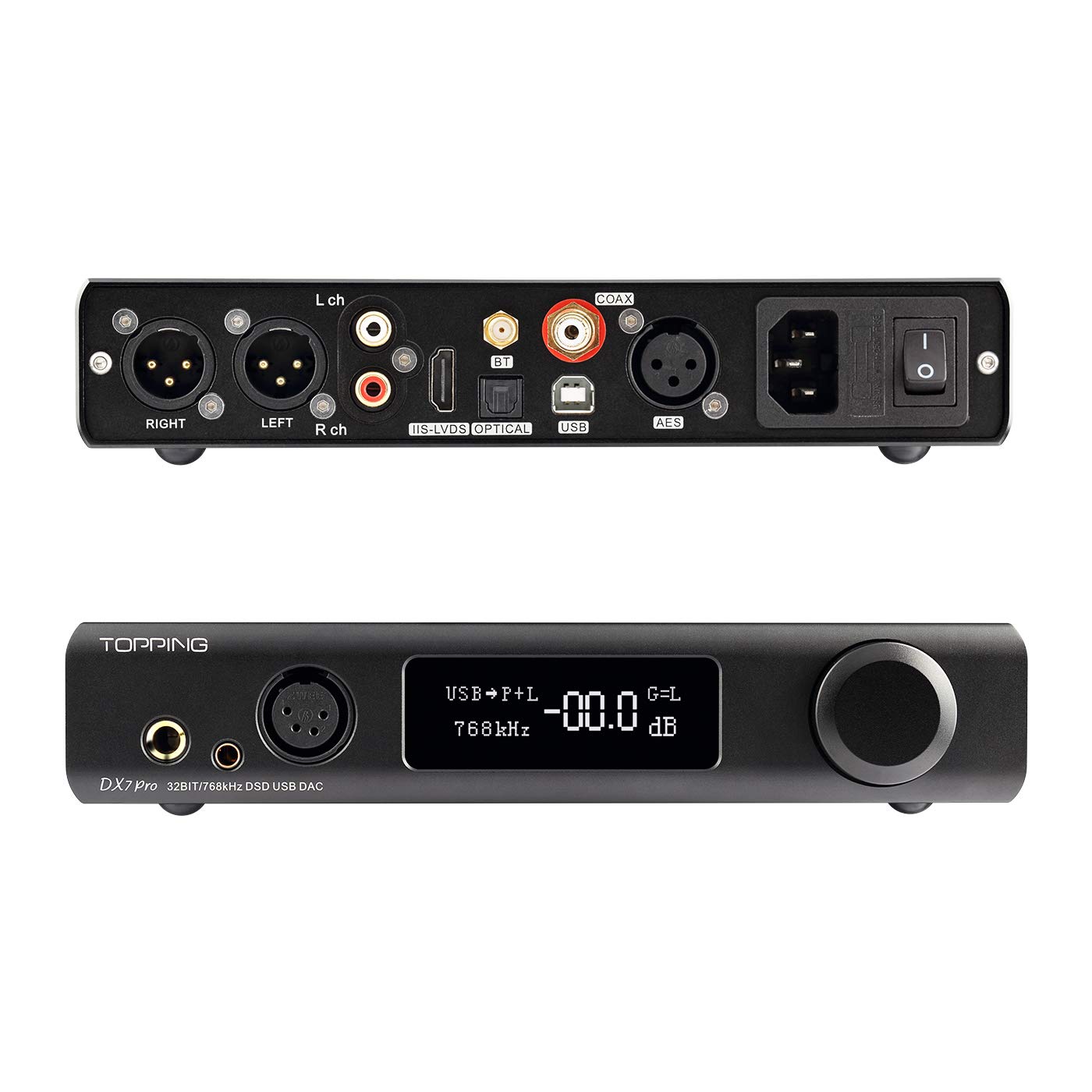
Controls & Connectivity
Front panel looks clean and tidy, the sneaky volume pot also works as a standby On/Off button
I really like the positioning of all those 3 headphone outs and I’m glad besides a 4-pin XLR and ¼” headphone jack they also used the best-balanced headphone jack of the moment: 4.4mm Pentaconn. Volume knob is super smooth to the touch and has 99 physical steps. However, the volume control is 100% fully digital and at 99 steps it is so easy knowing how much volume is there left for my headphones.
OLED screen has 3 brightness levels and at the highest setting it is not too bright, it shows all the important information like the selected digital input, analog output, the gain settings, the sampling frequency (for PCM material) or the DSD rate and the volume position from -99 to 0 dB.
Taking a glance on the back is clear that DX7 Pro targets high-profile and knowledgeable audiophiles, the i2S and AES inputs are a rare sight nowadays and I’m welcoming those, of course there is also a USB type-B input, a coaxial and an optical (Toslink) input. Since this is a fully balanced input to output DAC it has RCAs and XLRs on the back.
One important aspect is that with the volume pot that works as a menu navigator can be accessed only basic features of DX7 Pro, if you want to fully customize it to your liking, I recommend using the remote control from the package. With it, you can select from 7 digital filters that are working on the hardware level from the ES9038 PRO itself, you can select 3 brightness levels, you can select your desired analog output: RCA, XLR, RCA+XLR, PO (phone out) or LO (line out) + PO, a setting for every needs. DX7 Pro has also a small memory buffer and it will remember the volume settings for every selected output, you can have 0 dB on the line-out and just -20 db on the phone out, quite convenient!
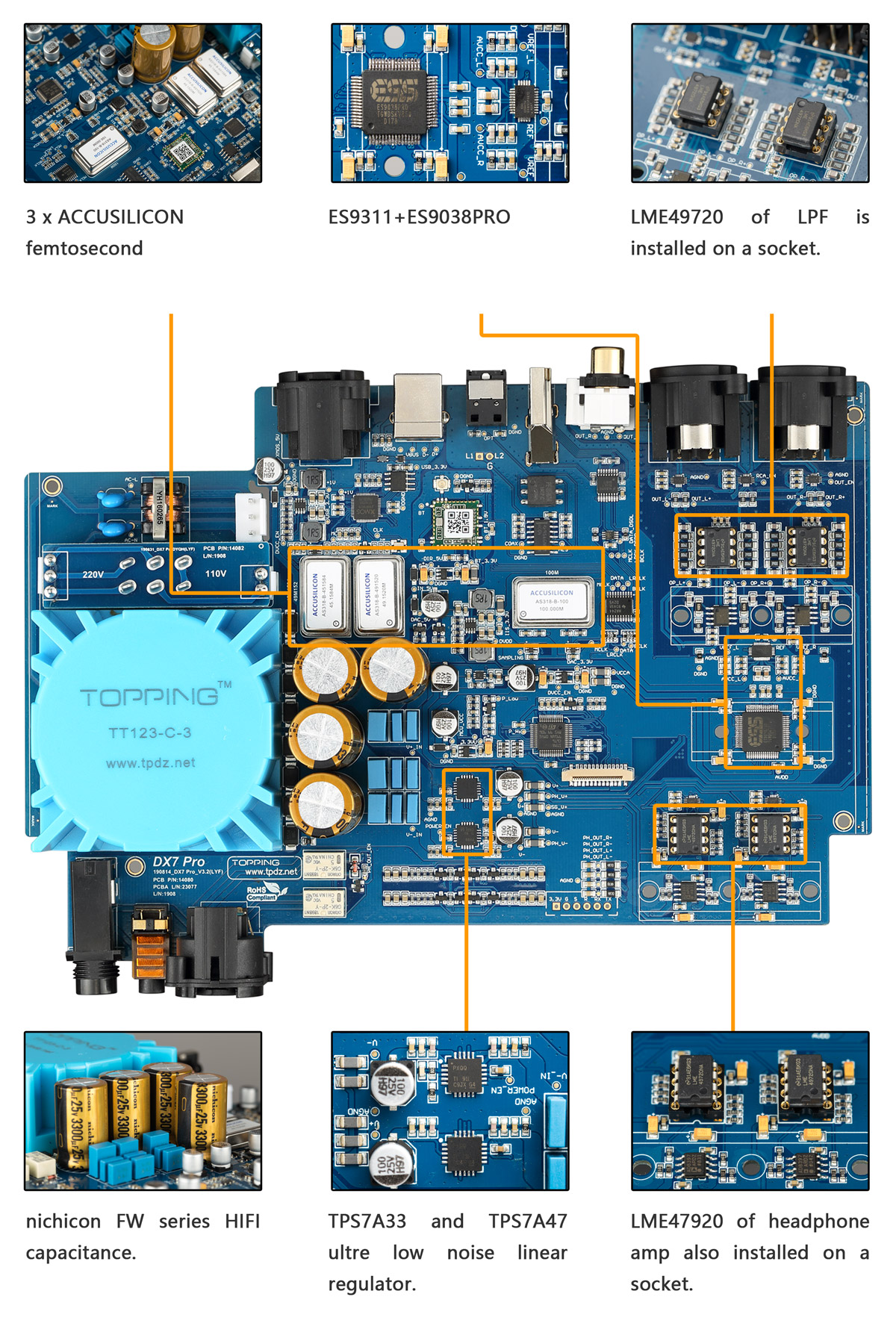
Tech Specs & Detailed information
I will just briefly summarize all the important specs as I already mentioned some of those.
ES9038 PRO DAC chip + 3 Accusilicon femtosecond clocks are doing all the digital work, the USB decoder is the famous XU208 from XMOS and custom drivers from Thesycon will ensure a good stability. DX7 Pro can natively decode DSD512 and PCM up to 768 kHz at 32 bits on the USB, only I2S input is capable of decoding DSD1024.
DX7 PRO is using a proprietary toroidal transformer along with some audio-grade Nichion capacitors. From my point of view this is an advanced power supply with multiple levels of isolation for an accurate sound reproduction. DX7 Pro ditched the TPA6120A2 headphone amplifier circuit in favor of the cleaner sounding LME47920 dual op-amps. Since Topping is using two of them it means the headphone amp circuit is fully balanced as is the DAC part.
What is kind of interesting is that both op-amps are socketed, so in theory if you wish to roll some dual op-amps and maybe use something fancier like Burson V6 or SparkoS Labs dual op-amps, you can do that. Even the DAC output stage consisting of two LME49720 are also put on DIP-8 sockets, but sincerely I do not recommend changing those. Those are already very good, have been tested for good performance and thermal stability and other ones might not sound as good, the output stage is quite a sensitive part, leave it as it is.
The 1.7 Watt headphone amp section is really powerful, didn’t expect those numbers at this size and weight. What is not so impressive and a bit worrisome especially for low impedance IEM/headphone users is the output impedance of the headphone outputs. The SE 1/4” one has it at 4.7 Ohm and both balanced outputs at 9.4 Ohm, meaning the balanced out might not have the best damping factor for low impedance headphones.
OK everyone, I think it is time to have a long listening session.

Sound Performance
I. In a headphone-based system
A. Using sensitive In-Ear-Monitors
Before going deep into its performance two things needs to be mentioned.
First one is the output impedance of both HP outputs, for a good damping factor the headphone impedance should be at least 8 times higher than that of the source, this is called the “rule of eights”.
SE output has 4.7 Ohm x 8 = means a headphone with impedance of at least 37.6 Ohm should be used for the best results. Of course, it doesn’t mean lower impedance ones will not sound fine, it’s just that the damping factor will be decreased and the diaphragm control will be affected.
Both balanced HP outputs have it at 9.4 Ohm x 8 = a headphone with at least 75.2 Ohms should be used for the best results.
I presume that Topping increased the HP impedance so that the headphone amp circuit will never be over-driven into clipping, but this is just a wild guess and not a fact.
I personally don’t recommend using sensitive IEMs on the balanced out and only on the low gain setting for safety reasons, on high gain it can go loud really fast.
Second thing that needs to be mentioned is that all three headphone outs have the noise under a strict control so I’m pleased to report DX7 Pro is completely noise free on all three headphone outputs, on Low or High gain, it doesn’t matter, the background is free of any gremlins or mains hum. Isolation circuit plays a big role here and DX7 Pro is among the most silent units I tested of late. As a brief comparison it has much less mains noise than $2195 Mytek Brooklyn DAC+, a bit less than $1500 KECES S3 and of course lower than that of $500 Gilmore Lite Mk2, $400 Burson Playmate, $500 Erzetich Bacillus and about on the same level with $599 Aune Audio S6 PRO and with my reference $3000 Matrix Audio Element X. So, IEM users rejoice, on the SE out this thing rocks pretty hard.
I also observed that Low gain has a really slow volume rising curve, even with super sensitive stuff I was sitting comfortably at about -30 dB, so plenty of headroom and volume doesn’t increase very fast. High gain is of course another story, right there DX7 Pro will show its biceps especially on the 4-in XLR.
I decided to listen to the lowest impedance IEMs in my possession and those were the 16 Ohm Simgot EN700 PRO and following the rule of eights I should have a lower damping factor, but sincerely at a sensitivity of 101 dB I didn’t feel a slower transient response or some weaker dynamics. They sounded as good as I remembered those on my big rig. DX7 Pro has lots of authority, a hard grip and a good diaphragm control and if needed IEMs can be easily used no problem with it.
Basically, the same happened when I moved to the 23 Ohm 4-way balanced armature driver FiiO FA7, with a sensitivity of 110 dB/1 mW the damping factor was not affected and those sounded the same as I remember them on high-performance headphone amps.
What was very obvious from the start is that DX7 Pro chooses to have a super linear and honest sounding signature. It doesn’t want to add or hide something from the recording, if it’s there it will show it, be it good or bad. DX7 Pro is not a forgiving type of DAC and headphone amp combo. It was tuned towards a revealing nature like a magnifying glass for your music.
I personally like this kind of performance, for me any EQ or DSP will hide part of the truth or will beautify the ugly truth, honest and linear is only way to go. If you want to add a bit of character, spark or warmth, you can do that with an amplifier (pre/integrated/power) of your choice.

B. Using full-sized headphones
I was very curious how DX7 Pro headphone amp section will behave with current-driven low impedance planar-magnetic headphones.
I decided listening first to the 20 Ohm Quad ERA-1, at about 94 dB/1mW these are neither easy to drive nor very power hungry. On the 4-pin XLR output and engaging High gain I could go up to -18 dB volume and my comfortable level would be at -20 dB. So, in the worst-case scenario I would have another 18 dB of headroom and dynamic range left on tap, DX7 PRO is incredibly powerful but the final decisive test is yet to come.
Quad ERA-1 was the only case when I felt the 9.4 Ohm balanced HP out impedance took away part of the magic ERA-1 are known for: speed and impact! It was not a night and day difference compared to say a Benchmark HPA4 but it was quite obvious especially with faster paced music.
ERA-1 lost that nimble and light on feet approach to music reproduction, that kick that instantly rises the mood and the very clear outline of the notes (the leading edges). It sounded like it lost a bit of pace and can’t keep up with faster transients. I believe the diaphragm was just not controlled to its best and this is what happened.
When I moved to the lowest sensitivity and hardest to drive headphone from my stable things improved a lot. Hifiman Arya at 35 Ohms and at 90 dB/1 mW is not an easy task to move around and control, yet at -15dB I was comfortable driving them and my hearing threshold would stop at -12 dB. As a result, in the worst-case scenario I would have 12 dB of headroom left, that is plenty even for Chesky or Reference Recordings.
I was pleased to find DX7 PRO capable at driving this particular pair of headphones and I know a lot of dedicated headphone amps that can’t do that.
Weirdly enough, damping factor was not a problem anymore, they kicked, they punched and they delivered incredibly dynamics and I was basically listening to them at their fullest potential. Even soundstage size didn’t suffer at all, its internal headphone amp section is really capable and can move a lot of air if needed.
Moving on to the 150 Ohm Sennheiser HD660S was an easy game for it, at -25 dB I was sitting in the middle of a rock gig and at -28 dB that would be my comfortable listening level. As expected, HD660S were fully driven to their fullest. What I enjoyed a lot was the driver control, an instant start and stop of the headphone driver, HD660S sounded like being on steroids and more power than what’s on tap would be just overkill.
From my longer headphone listening sessions I learned a few things:
– On the balanced 4.4 mm/4-pin XLR you should use 35 Ohm or higher impedance headphones and all the kick and impact will be yours to have
– On the SE ¼” use any IEM or portable headphones that has more than 16 Ohms for the best results
The rest is history, headphone listeners were not overlooked this time around and DX7 PRO delivered everything I wanted it to be.

C. Wireless Performance
Luckily my smartphone is BT 5.0 enabled and LDAC/AptX-HD compatible. Connecting it to DX7 PRO was easier than expected: you just need to select the BT input on DX7 PRO, search for DX7 PRO on your phone and connect to it. DX7 PRO was connected to my KEF LS50W all this time so I could hear if the signal drops or not and I started moving around my flat. At a short distance with 3 concrete walls between us the signal was still going strong, at 10-meter distance with 2 concrete walls it was still good, only in the last room with 3 concrete walls between us I was losing the signal and it would drop few beats and stutter in the process.
However, compared to other Bluetooth receivers that I have tested not too long ago, like FiiO BTR3 and Q5S, DX7 PRO had a stronger and steadier signal, its Bluetooth antenna was put there exactly for that purpose.
I fired some Tidal Masters (192 kHz) on my phone and DX7 PRO played all that without a problem. The overall performance took a small hit. Everything sound good, just minor flaws like detail retrieval was not the same as going wired via USB or I2S. When I moved to simple CD quality content from Tidal (16 bit 44.1 kHz) the sound quality gap shrunk to a point of being almost indistinguishable from the wired performance. In the end LDAC is transmitting data at up to 990 kB/sec, that is already lossless quality and I almost couldn’t tell which one is which. DX7 Pro seems to be the perfect bed-side wireless receiver for some late-night jazz sessions.

II. In a speaker based system
The active KEF LS50W that I’m using already have an internal DAC, streamer and dual mono amps. I like a lot of things about them but there is one thing that definitely lacks in terms of resolution and pin point imaging: their internal DAC section.
Luckily, LS50W have an additional analog input so I can use external sources with them bypassing their digital processing. When I connected the DX7 PRO to LS50W I was sincerely not shocked hearing more hidden details, more little nuances, the internal DAC of LS50W can’t possibly render or show me those. It happened many times already and it wasn’t something new to me.
What was quite unusual is how fast coaxial drivers transformed into something else. They suddenly started throwing punches at me with incredible kicks into my chest, bass notes suddenly reached lower octaves, I didn’t particularly understand, how was that possible?
I connected a ChromeCast Audio enabled TV to DX7 PRO and again fired some Tidal Masters, but this time I focused on the transient response and on the decay of the notes.
Listening to Moonlight Sonata 3rd Movement was an almost aggressive performance, multiple notes hit from different angles, decaying in an instant and striking me again and again. I believe this particular coaxial driver loves this kind of control and speedy transient response. DX7 PRO shown not only brute power but also finesse and a very well-polished presentation. When I am using only its DAC part, I can hardly find any complaints at all.
Listening to Mozart Violin Concertos it started pushing all the notes away from me, the air moving around the room was so obvious. Without a doubt, DX7 Pro possesses a well-defined pin point imaging and all the spatial cues were easily spotted, I don’t even need to close my eyes anymore to see them flying around me. Picking up individual sounds from a crowded track is like playing a game on Easy Mode.
Vivaldi – Che Giova II Sospirar – I’ve heard the widest soundstage size of the evening and what an open wide presentation it was! At one point it resembled the performance of a bigger stand-floor speaker. Sound was always far and wide, bold and imposing, with impressive dynamics and fast decays of the notes.

Moving further to something more aggressive sounding like the newest album by Lacuna Coil – Black Anima was an wait a sec moment for me. DX7 Pro was just created for faster paced music, where all the frequency range is needed. Bass notes started waving my ears and all that drive and energy was instantly felt inside me, turning me to the dark side. The voice of Cristina was like avoiding the crowd around her and paving its way towards more. This is a mediocre mastered album but the raw energy is there in spades and DX7 PRO is not shy showing off all those traits.
In terms of frequency response DX7 PRO is super linear and plays with the big boys, it is not rounding the frequency extremes and nothing will hide from its sight, I didn’t spot even a glimpse of roll-off.
All my usual bass tests were passed with flying colors. Sub-bass is deep reaching, has a good sustain and it is always clean sounding. The grainy & blurry bass notes are never present, even on bad mastered music and of course multiple layers of bass can be spotted on the right music. Mid-bass is not overdone like how others are doing nowadays.
Midrange is on the same level, never enters or leaves the spotlight, always in the middle of the mix. Voices carry emotions and are never dry sounding, nor too wet and warm. I think in terms of midrange performance it is like disappearing without adding a hint of color. If you are looking for a warmer and charismatic sounding DAC, this one will not be for you.
DX7 PRO is brutally honest with everything and shows all that is hidden in a natural manner.
Treble is exceptional, always clean, sparkly up top without making me lower the volume. It bites at times, has a really good texture and I can feel the cymbals hitting my eardrums. It is extremely transparent and very detailed to a point that I started questioning myself If I needed to spend 5 times more for a slight improvement.
In terms of detail retrieval and transparency, DX7 PRO is staying in the top 3 for me at any price point.

Comparisons
Topping DX7 PRO ($599) vs Topping D70 ($499)
I will skip the specs, design, weight, functionality aspects and will focus only on the DAC part of both devices.
The moment I listened to D70 I knew it rolls-off a bit in the sub-bass and upper-treble area. As a result, D70 is not super linear and will not show crazily vivid the lowest octaves or the sub-sonic trebles. DX7 PRO on other hand is brutally honest and has it all from the lowest to the highest notes. D70 is not aggressive, speedy or very articulated. D70 will not hit hard, has a weaker impact and is not very impressive with faster paced music, it’s good but not impressively good. D70 is a bit romantic and slower sounding, crazy good with blues and jazz and passable with rock and electronica. DX7 PRO is opposed to that, it’s mean, kicks hard and doesn’t care if you like that or not.
Where D70 wins hands down is the localization of all the sounds around the listener, all those notes are also pushed a bit farther away into the mix, you hear them far away on D70 and closer on DX7 PRO. Soundstage size is wider on D70 to a point of being distracting at times, DX7 PRO is closer but more precise somehow, you feel everything with your body.
D70 puts a small emphasis on midrange and makes it warmer, sexy and inviting, you just want to listen more of that guitar, violin or of that soothing and inviting voice. DX7 Pro has nothing like that, just a linear and honest midrange and nothing more.
Topping DX7 PRO ($599) vs SMSL M500 ($399)
People who expected M500 to crush all the competition to oblivion will be crushed to know that DX7 PRO is even better on almost everything. Biggest change is in terms of frequency response. M500 puts an emphasis in bass and upper treble, as a results midrange takes a hit and sounds a bit dry and lifeless. It sounds V-shaped and not as linear as I hoped it to be.
DX7 PRO by comparison doesn’t emphasis anything, just a straight line from point A to point B. Few might like the extra energy in the bass and treble of M500, I’m however not that impressed by that. Linearity is my target and DX7 PRO is much better at that. DX7 PRO also has an overall better control and a wider stage across the board. It is deeper and wider sounding as well. It may lack the MQA capability, but everything else is better on it.
Topping DX7 PRO ($599) vs Matrix Audio Element X ($3000)
I will again skip all the functionality and features since Element X incorporates a true streamer and an internal USB-drive player controlled by a simple smartphone app.
When it comes to pure DAC performance, I was actually quite surprised by how close both units sounded. DX7 PRO is kind of like a baby Element X to me. Linearity and frequency response wise both are neck and neck on the same level. Element X is slightly better in the bass department, by better I mean not just going lower but by having it even clearer, I guess the Noratel transformer said its word.
Soundstage wise both are good, still Element X pulls ahead and shows few additional layers and a deeper presentation, I can look easier into my recordings with it.
Detail retrieval is basically the same, both will show any nuance without breaking a sweat. At only 1/5 of the price of Element X, DX7 Pro looks like a crazy value to me, I’m impressed…
I can go on and on with my comparisons by I’m already on the 9th page and it seems that without wanting it, this is my longest written review to date.

Conclusion
Topping DX7 PRO seen a long development time and optimization process, it is already at its third iteration, I know and I feel while listening to it all the care it went through in terms of design, specs and measurements. I can’t deny the awesome specs and measurements it possesses.
It delivers a solid performance on all fronts; it has everything a knowledgeable audiophile would desire and as result I consider it an incredible all-in-one device packed with features that came as a bonus for a close to perfect audio performance. At just $100 more compared to the older X7S I believe DX7 Pro fully justified its price and at $599 this is currently my best recommendation.
Topping DX7 PRO can be purchased by following this link (they offer 30-day returns in case you don’t like it, an extra 1 year of warranty and lowest price guarantee).
PROS:
- Sleek looking device, solid build quality
- An impressive feature-packed 4-in-1 device (DAC/preamp/headphone amp/BT receiver)
- Linear and super extended on both ends, lacks any sound coloration
- Impressive levels of transparency and resolution
- Precise pin-point imaging
- Wide soundstage, deep sounding as well
- Excellent pace, rhythm and timing with crazy dynamic swings
- Linear and uncolored headphone amp section with lots of power to spare
- Lacks any noise or distortion
- Widest selection of digital inputs
CONS:
- High output impedance on all headphone outputs limits the damping factor of low impedance IEMs/Headphones
ASSOCIATED EQUIPMENT:
- DACs: Topping DX7 PRO, Topping D70, Matrix Audio Element X, KECES S3, SMSL M500
- Headphone amps: Benchmark HPA4, Erzetich Bacillus, Headamp Gilmore Lite Mk2
- IEMs: FiiO FA7, Simgot EN700 PRO
- External S/PDIF interface: Matrix X-SPDIF2
- Full-sized headphones: Quad ERA-1, Hifiman Arya, Sennheiser HD660S
- Loudspeakers: KEF LS50W
- Interconnects: QED Reference XLR (x2), Aune AL3 XLR
- Power Cables: Isotek EVO3 Premier (x2)
- Balanced Isolation Power Conditioners: PLiXiR Elite BAC400, KECES BP-600



